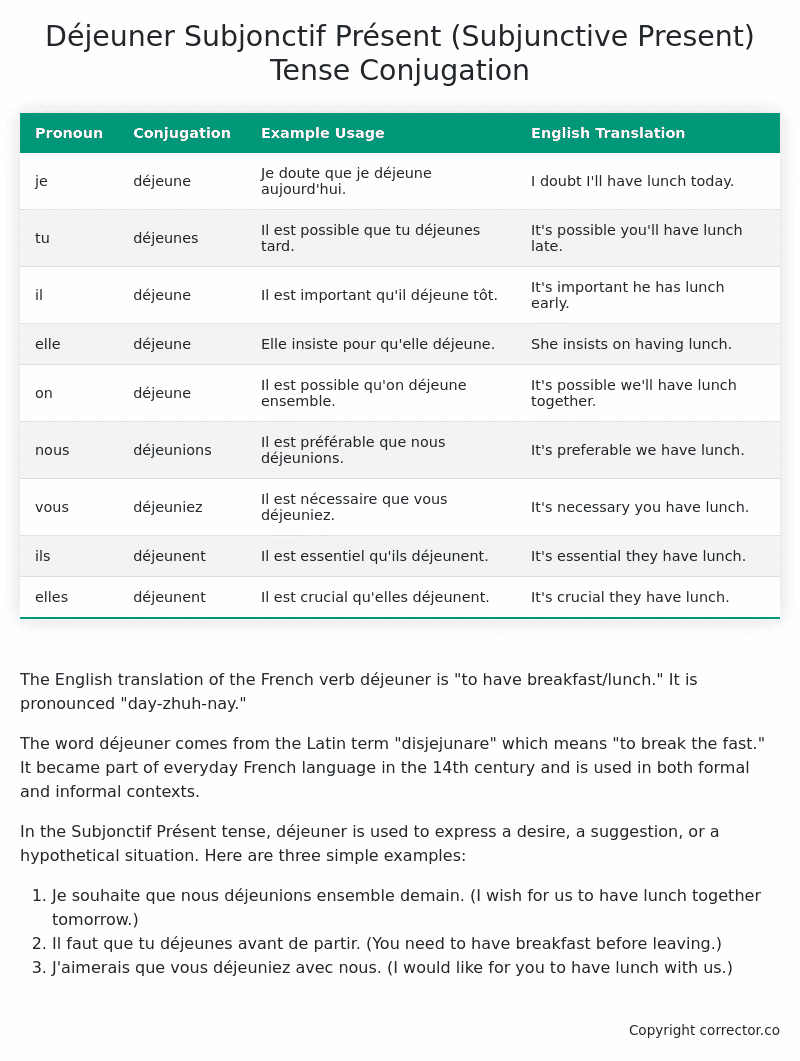Subjonctif Présent (Subjunctive Present) Tense Conjugation of the French Verb déjeuner
Introduction to the verb déjeuner
The English translation of the French verb déjeuner is “to have breakfast/lunch.” It is pronounced “day-zhuh-nay.”
The word déjeuner comes from the Latin term “disjejunare” which means “to break the fast.” It became part of everyday French language in the 14th century and is used in both formal and informal contexts.
In the Subjonctif Présent tense, déjeuner is used to express a desire, a suggestion, or a hypothetical situation. Here are three simple examples:
- Je souhaite que nous déjeunions ensemble demain. (I wish for us to have lunch together tomorrow.)
- Il faut que tu déjeunes avant de partir. (You need to have breakfast before leaving.)
- J’aimerais que vous déjeuniez avec nous. (I would like for you to have lunch with us.)
Table of the Subjonctif Présent (Subjunctive Present) Tense Conjugation of déjeuner
| Pronoun | Conjugation | Example Usage | English Translation |
|---|---|---|---|
| je | déjeune | Je doute que je déjeune aujourd’hui. | I doubt I’ll have lunch today. |
| tu | déjeunes | Il est possible que tu déjeunes tard. | It’s possible you’ll have lunch late. |
| il | déjeune | Il est important qu’il déjeune tôt. | It’s important he has lunch early. |
| elle | déjeune | Elle insiste pour qu’elle déjeune. | She insists on having lunch. |
| on | déjeune | Il est possible qu’on déjeune ensemble. | It’s possible we’ll have lunch together. |
| nous | déjeunions | Il est préférable que nous déjeunions. | It’s preferable we have lunch. |
| vous | déjeuniez | Il est nécessaire que vous déjeuniez. | It’s necessary you have lunch. |
| ils | déjeunent | Il est essentiel qu’ils déjeunent. | It’s essential they have lunch. |
| elles | déjeunent | Il est crucial qu’elles déjeunent. | It’s crucial they have lunch. |
Other Conjugations for Déjeuner.
Le Present (Present Tense) Conjugation of the French Verb déjeuner
Imparfait (Imperfect) Tense Conjugation of the French Verb déjeuner
Passé Simple (Simple Past) Tense Conjugation of the French Verb déjeuner
Passé Composé (Present Perfect) Tense Conjugation of the French Verb déjeuner
Futur Simple (Simple Future) Tense Conjugation of the French Verb déjeuner
Futur Proche (Near Future) Tense Conjugation of the French Verb déjeuner
Plus-que-parfait (Pluperfect) Tense Conjugation of the French Verb déjeuner
Passé Antérieur (Past Anterior) Tense Conjugation of the French Verb déjeuner
Futur Antérieur (Future Anterior) Tense Conjugation of the French Verb déjeuner
Subjonctif Présent (Subjunctive Present) Tense Conjugation of the French Verb déjeuner (this article)
Subjonctif Passé (Subjunctive Past) Tense Conjugation of the French Verb déjeuner
Subjonctif Imparfait (Subjunctive Imperfect) Tense Conjugation of the French Verb déjeuner
Subjonctif Plus-que-parfait (Subjunctive Pluperfect) Tense Conjugation of the French Verb déjeuner
Conditionnel Présent (Conditional Present) Tense Conjugation of the French Verb déjeuner
Conditionnel Passé (Conditional Past) Tense Conjugation of the French Verb déjeuner
L’impératif Présent (Imperative Present) Tense Conjugation of the French Verb déjeuner
L’infinitif Présent (Infinitive Present) Tense Conjugation of the French Verb déjeuner
Struggling with French verbs or the language in general? Why not use our free French Grammar Checker – no registration required!
Get a FREE Download Study Sheet of this Conjugation 🔥
Simply right click the image below, click “save image” and get your free reference for the déjeuner Subjonctif Présent tense conjugation!

Déjeuner – About the French Subjonctif Présent (Subjunctive Present) Tense
Formation of the Subjonctif Présent
Common Everyday Usage Patterns
Interactions with Other Tenses
Summary
I hope you enjoyed this article on the verb déjeuner. Still in a learning mood? Check out another TOTALLY random French verb conjugation!


